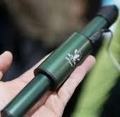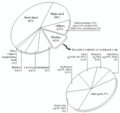The FTC's New Marketing Rules To Squash Greenwashing
by: fast company, 2011-06-10 16:52:37 UTC
It's been scarily simple for companies to make false claims about how good their products are for the environment, but now the government is stepping in.

It's scarily simple for companies to make inauthentic "green" claims about their products. They can just slap an unregulated green seal of approval on their product. They could just make up their own green approval program, even. But that's all about to change later this year when the FTC updates its Green Guides for the use of environmental marketing claims. We had a chance to speak with Mark Petruzzi, VP of Certification & Strategic Relations at Green Seal (a nonprofit third-party certification agency that worked with the FTC on the guides), about what the changes will mean in the world of marketing.
The biggest change, according to Petruzzi, is that companies will no longer be able to stick unverified labels, logos, and seals of approval on their products without qualifying their statements. "There is a proliferation of companies putting a green logo on their own product.... But if a logo is on a product, the consumer
naturally assumes it's a third-party certification," says Petruzzi. Under the FTC's new rules, companies will have to clearly state what logos mean and who is verifying them. And violators could be taken to court by the FTC.
Similar rules will apply to trade associations that have come out with their own green labeling programs--albeit ones that usually have low points of entry. "At the end of day, these are industry associations," says Petruzzi. "Now they need to say that they are industry associations."
All of this should benefit third-party certifiers like Green Seal, simply because companies can use these certifications without attaching embarrassing qualifying language (i.e. "This logo comes from an internal green certification program").
But are these changes too late for consumers who have become so wary of false claims and greenwashing that they'll never believe anything? Petruzzi hopes that consumers will ultimately start to take environmental claims more seriously. "We need to see people treating environmental claims with the same seriousness that they treat other health and safety claims."
Reach Ariel Schwartz via Twitter or email.
Read More: Can the Green Building Council Polish LEED's Tarnished Standards?


 Your Next Flight May Be Powered By Algae--And A Lot Cheaper
Your Next Flight May Be Powered By Algae--And A Lot Cheaper
by: fast company, 2011-06-10 22:36:41 UTC
Biofuel-powered aircraft have finally been approved, and could cut airlines' fuel costs in half. When's the maiden flight?

Biofuel-powered aircraft have finally moved into the real world now that the U.S.-based Air Transport Association has approved a fuel blend of up to 50% organic waste and non-food material (i.e. algae and wood chips) for passenger planes. This means that the next time you take a flight, it may be powered partially by waste. So why should you care? You're still going to be sitting in a cramped cabin and groped by TSA, right?
Ultimately, this could lead to lower flight prices, or at least help save cash-strapped airlines. Cars have had alternative fuel options for years--it's possible to go
out to a dealership today and pick up a vehicle that can be powered by
electricity or biofuel. But up until now, there have been few options
(beyond fuel efficiency techniques) for passenger airlines hoping to
avoid high fuel prices and carbon emissions.
Consider: Jet fuel currently costs $131 per barrel. Algae fuel could ultimately cost less than $50 a barrel, and jatropha (another promising airplane biofuel) costs only between $50 and $80 per barrel. High fuel costs mean plane tickets cost more money. Algae-powered planes could mean that you will at least be paying less money for the dehumanizing experience of air travel.
And now that a large biofuel blend is allowed on passenger aircraft, biofuel companies like Codexis, Solazyme, and Neste Oil can tap into the $139 billion per year aviation fuel market, according to Bloomberg. This could accelerate their development--and lead to better biofuels in our cars, too.
Want to take a spin in a biofuel-powered plane? Lufthansa plans to start a six-month trial in the next few weeks that will see the airline test a 50% blend of jatropha, camelina, and animal waste in one plane engine. The biofuel-powered flights will travel from Hamburg to Frankfurt.
[Image by Flickr user Smemon]
Reach Ariel Schwartz via Twitter or email.


 Vinod Khosla Slaps Energy Storage With Some Tough Love
Vinod Khosla Slaps Energy Storage With Some Tough Love
by: Greentech Media: Headlines, 2011-06-09 17:28:04 UTC
I'd wager that investor Vinod Khosla is not going to be invited back to speak at the Energy Storage Association.
Khosla usually says something controversial, contrarian and clever. It might not always go down easy with the audience -- and it didn't on Tuesday night.
Khosla spoke to about 300 energy storage experts at the annual Energy Storage Association (ESA) meeting. He acknowledged the critical importance of energy storage, showed his knowledge of the sector, and had the crowd eating out of his hand. He then proceeded to dismiss many of the technologies that those at the industry gathering were working on as "toys" because of their inability to scale to truly solve grid-level problems. He also predicted that A123, the lithium-ion battery manufacturer would not be around in ten years.
That was less satisfying for the audience (which included A123). The incoming and outgoing chairmen of the ESA were somewhat aghast at the comments, although I'm sure Khosla would say them again.
Here's a summary of his talk:
He's looked at the smart grid and considers it "more smart hype than smart grid." We've covered his views on the smart grid, which include the statement that "automated meter reading is not smart grid." Khosla also has a common refrain that most forecasts and analysts are "as good as dart-throwing monkeys."
Concerning storage, Khosla said, "When I look at storage I think of the competition as peaker plants. You can bring on energy from peaker plants or bring on storage." Khosla saw this as a positive in that, "You know exactly what your competition is."
"What is changing with rooftop solar," he continued, is that "We haven't dealt with lots and lots of generators in a serious way," Khosla then proceeded to show the same two slides on wind and solar variability already shown at this event a dozen times. Those slides can be found here if you're interested. Bottom line -- solar and wind are intermittent.
"The problem in the grid is managing uncertainty." The drivers of uncertainty, he went on to list, were increased amount of renewables, increased capital risks of fast-moving technology, and increased security requirements.
One can increase certainty by aggregating supply over geography, over time (that's what storage is) or by using information technology, according to the investor.
"Storage is a key element of certainty," said Khosla, telling the storage industry audience, "Your task and role is far more important than people realize."
Khosla said that energy storage is an alternative to many smart grid issues and an opportunity for a smart grid "re-do." You can have:
-
Smart meters, HANs, and thermostats -- or storage.
-
Demand response -- or storage
-
Real-time pricing -- or storage
-
More transmission lines -- or storage
-
intelligent consumer electronics -- or storage
Khosla went on to say that storage is the key to better power utilization, a more reliable grid, and not having to hassle consumers with programming their dishwasher. More local storage means fewer security requirements and fewer potential cyber-wars.
Smart Power Electronics
Khosla returned to his refrain about the need for better power electronics.
In the past, he's said, "The grid really equals smart power electronics. It's not even about the networks." He added, "We need a whole new class of devices and systems. A 50-year-old transformer made of copper wire wound around a ferrite core can't respond to a signal, so we can't control it," adding, "If we invest in new power electronics devices, things will change radically. The design of existing systems will change based on these new components."
His advice to entrepreneurs: "We have to focus on power electronics."
He sees smart power electronics as a way of "decoupling the rigid grid" and getting us away from a "hard-coupled grid" with energy storage as a "great shock absorber" so that a tree falling in Ohio doesn't knock out the power grid in New York.
While laptops and consumer electronics follow Moore's Law of performance doubling every 18 months, he saw the grid under "Westinghouse's Law" with big change occurring every 50 to 70 years. He cited transformers as an example of the need for "fundamental new power electronics devices."
"The problem in power electronics is that no one has invented a new device," according to Khosla. There's been "a little work in IGBTs" but "We need a new class of powers devices and systems." He saw "no reason to be using copper winding" in a transformer, a technology from the 1800s with few changes over the last century save for some cooling and changes in materials.
"We need new gallium nitride (GaN) devices and transistors and we will bypass Westinghouse's law," according to Khosla. In ten years, we'll see changes in power systems using solid-state transformers that will create an "uncoupled" grid.
Khosla continued by reframing the debate with a series of thought-provoking questions. "What if we asked":
-
Energy efficiency vs. demand response? (If your air conditioner was 80 percent more efficient, it wouldn't need to be smart.)
-
Energy efficiency vs. conservation or insulation?
-
Storage vs. demand response? (Demand response would disappear with storage, according to The Vinod)
-
Storage vs. distributed generation?
-
Transmission vs. storage?
-
Load regulation vs. active devices?
-
Command and control vs. resilient networks?
As mentioned, Khosla described lithium-ion batteries as "toys that can't be deployed at scale." He said that lithium-ion was "too volatile" and "too expensive." To be economical, energy storage has to be fundamentally safe -- without the necessity to wrap tons of management and safety equipment around it to keep it from exploding or catching fire.
He dismissed compressed air energy storage (CAES) and pumped hydro as technologies that can make a business but "do not change the nature of the grid."
The Khosla Ventures energy storage portfolio includes:
-
Stealthy LightSail which looks like containerized mobile CAES
-
Sakti3 - Solid-state lithium ion battery for automotive applications
-
Seeo - Solid-state lithium ion on a polymer electrolyte (Seeo just raised an additional $15 million from KV, et al.)
-
Pellion - Rechargeable magnesium-ion battery that is "inherently safe with no liquid electrolytes"
-
Quantumscape - The ARPA-E site calls it a “completely new class of electrical energy storage devices for electric vehicles that has the potential to provide ultra-high energy and power densities, while enabling extremely high cycle life.”
-
A ceramic battery firm?
Khosla sets the bar for storage as round-trip efficiency better than that of lead-acid batteries with costs below $100 per kilowatt-hour.
"Diversity is key," said the investor, concluding: "My willingness to fail gives me my ability to succeed."
New system created for recycling composite boats
by: Gizmag Emerging Technology Magazine, 2011-06-09 22:27:21 UTC

We've all heard about old metal car bodies being melted down for recycling, but what happens to the composite hulls and superstructures of past-their-prime recreational boats? Well, not much. Generally, they just end being sunk, burned, or put in a scrapyard. Sometimes, the composites are ground up and added as filler to virgin material. An alternative may be on the way, however, as researchers have discovered a new method for separating the composite components for future reuse...
Continue Reading
New system created for recycling composite boatsTags: Boats,
Recycling
Related Articles:


 World's first Bluetooth 4.0 heart rate monitor will catalyze new genre of smartphone apps
World's first Bluetooth 4.0 heart rate monitor will catalyze new genre of smartphone apps
by: Gizmag Emerging Technology Magazine, 2011-06-10 06:13:42 UTC

OEM/ODM specialist Dayton Industrial is set to commence volume production of a low energy Bluetooth 4.0 heart-rate chest belt using Nordic Semiconductor's new µBlue nRF8001 chip. That might not seem all that ground breaking at first glance, but it’s a significant event likely to kickstart a whole new genre of health and fitness related smartphone apps which use the wireless heart-rate (HR) belt to monitor, display and analyse heart rate data. Indeed, I can see a whole new and exciting range of training apps which use social networking to support and share one's progress...
Continue Reading
World's first Bluetooth 4.0 heart rate monitor will catalyze new genre of smartphone appsTags: Bluetooth,
Health,
Heart Rate Monitor,
Smartphone,
Social Networking,
World's First
Related Articles:


 Self-taught metallurgist creates lighter, stronger steel in a flash
Self-taught metallurgist creates lighter, stronger steel in a flash
by: Gizmag Emerging Technology Magazine, 2011-06-10 08:43:40 UTC

Having been around for a few centuries, steel is what is known as a “mature technology” and the basic process of heat-treating has remained largely unchanged in the modern age. So when self-taught metallurgist Gary Cola approached engineers at Ohio State University claiming to have found a way to increase the strength of steel by seven percent, they were justifiably skeptical. However, after the engineers tested steel produced using the new method, Cole’s claims were borne out and the engineers set about understanding what was happening...
Continue Reading
Self-taught metallurgist creates lighter, stronger steel in a flashTags: Ohio State University,
Steel
Related Articles:


 INDEX Awards 2011: Design to Improve Life Finalists Announced
INDEX Awards 2011: Design to Improve Life Finalists Announced
by: Core77, 2011-06-09 20:30:00 UTC

A nice afternoon browse, today INDEX announced the 61 finalists representing 27 countries on six continents for this year's INDEX: Award. The Copenhagen-based organization will award a total of 500,000 Euros to 5 winners from the categories of Body, Work, Home, Play and Community based on the Jury selection for "Best Design to Improve Life."
Amongst the finalists are some of our favorite projects of the last year:
Autodesk's Online Sustainability Workshop
Bware Water Meter
Design for Change empowers children to change the world!
Janine Benyus' AskNature Website
Studio Formafantasma's exploration of materials
Novacem's Carbon-negative cement
OpenIDEO
Plumen Lightbulbs
Learning Landscapes
Hovding's inflatable Helmet
and more!!
Take a moment to look at some of these inspiring projects and we look forward to this September's winner announcements!
(more...)


 Utility Green Pricing Programs, Customer Participation Rates, 2002-2009
Utility Green Pricing Programs, Customer Participation Rates, 2002-2009
by: Environmental Leader, 2011-06-10 10:43:13 UTC

At the end of 2009, the average participation rate in utility green pricing programs among eligible utility customers was 2% with a median of 1%. These industry-wide rates have shown little change in recent years, though 2009 did see a decrease in participation rates, likely a result of the economic recession. Top-performing programs have demonstrated [...]
 Industrial Energy Efficiency Presentation From Carbon Trust
Industrial Energy Efficiency Presentation From Carbon Trust
by: Environmental Leader, 2011-06-10 10:48:56 UTC

Henrietta Stock, a technology acceleration manager at Carbon Trust, discusses Industrial Energy Efficiency.
 Recycled plastic bottles to become casino uniforms
Recycled plastic bottles to become casino uniforms
by: Reuters: Green Business News, 2011-06-09 17:19:43 UTC
NEW YORK (Reuters) - U.S. uniform company Cintas Corp is betting on green for its new line of shirts for casino workers.











Comments by our Users
Be the first to write a comment for this item.